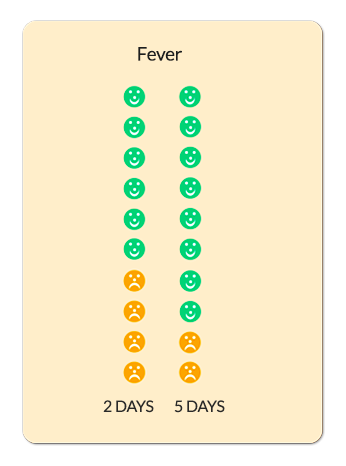Fever is extremely common in children and usually suggests that your child has an infection. If you use a thermometer to measure your child’s temperature, it’s really important that you do it accurately – you should also use a digital thermometer (under the armpit (axillary) for children 5 years and younger, and in the mouth for children over 5 years of age). The other option is to use an in-the-ear thermometer (tympanic), although these should not be used in babies below one month of age.
How to take your baby’s temperature- Viral infections are far more common than bacterial infections
- Symptoms such as runny nose, cough, wheeze, sore throat, red eyes, and diarrhoea are more suggestive of a viral infection than a bacterial infection. If a few people are unwell in the same household, this also suggests a viral infection (because viral infections are easily spread)
- Fever is common in babies up to 48 hours after receiving immunisations – it is OK to give paracetamol after the MenB vaccine without seeking medical advice if your baby is otherwise well
- Occasionally, children with fever can have a seizure or fit. This is called a febrile convulsion and most commonly occurs in children aged between six months and three years. They generally occur on day one of the fever, and in most cases have no long-term effects
- Viral infections tend to get better on their own and do not need treatment with antibiotics. Antibiotics may cause side effects such as rash and diarrhoea and can increase the risk of them developing antibiotic resistance
Watch this short video on fever by one of our consultants in Alder Hey:
When should I worry and what should I do?
Call 999 or go to A&E now if your child:
Becomes pale, mottled, and feels abnormally cold to touch
Is going blue around the lips
Severe breathing difficulty – too breathless to talk or eat/drink
Has a fit or seizure
Becomes extremely agitated (crying inconsolably despite distraction), confused or very lethargic (difficult to wake)
Has a stiff neck (cannot bend their neck to touch their chin to their chest)
Develops a rash that does not disappear with pressure (the ‘Glass Test’)
Is under 3 months of age with a temperature of 38°C / 100.4°F or above (unless fever in the 48 hours following vaccinations and no other red or amber features)
Call 111 or ask for an urgent GP appointment if your child:
Is finding it hard to breathe
Seems dehydrated (sunken eyes, drowsy or not passed urine for 12 hours)
Is becoming drowsy (excessively sleepy) or irritable (unable to settle them with cuddles, toys, TV, or snacks – especially if they remain drowsy or irritable despite their fever coming down
Has extreme shivering or complains of muscle pain
Is 3 to 6 months of age with a temperature of 39°C / 102.2°F or above (but fever is common in babies up to two days after they receive vaccinations)
Continues to have a fever of 38.0°C or more for more than five days
Is getting worse or if you are worried
If none of the above symptoms are present:
If your child is distressed, you may want to lower their temperature using paracetamol (Calpol) and/or ibuprofen. Use one and if your child has not improved 1 to 2 hours later you may want to try giving the other medicine. However, remember that fever is a normal response that may help the body to fight infection and paracetamol/ibuprofen will not get rid of it entirely.
Avoid tepid sponging your child – it doesn’t reduce your child’s temperature and may cause your child to shiver.
Encourage them to drink plenty of fluids.
You can get general advice on the NHS website or from your local pharmacy.
If your child develops any of the symptoms in either of the boxes above, follow the advice for that box.
Self-Care
Continue providing your child’s care at home. If you are still concerned about your child, call NHS 111 – dial 111.
If your child has any symptoms suggestive of COVID-19 (high temperature; new continuous cough – coughing a lot, for more than an hour or 3 or more coughing episodes in 24 hours; or loss of taste / smell) then arrange for your child to be tested via the NHS testing website or by calling 119. You and anyone in your support bubble must remain at home (isolate) until your child’s test results are back.
How long will your child’s symptoms last?
- Fever caused by a viral infection will usually start to improve within 2 to 3 days.
- If your child’s fever lasts for more than 5 days, get them seen by your GP.
- The chart below shows how long fever lasts in a child with viral infections. The faces represent 10 children who have seen their GP with a viral infection. Green faces are those children whose fever has recovered within that time period.

The diagrams above are taken from When Should I Worry.
Where should you seek help?
- If it is non-urgent, speak to your local pharmacist or health visitor.
- Or contact you GP practice and a qualified member of the clinical team will assess if your child needs to be seen urgently. For an urgent out-of-hours GP appointment, call NHS 111.
- You should only call 999 or go your nearest A&E department in critical or life threatening situations.